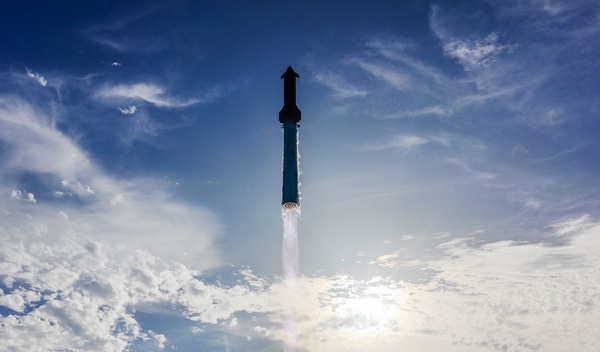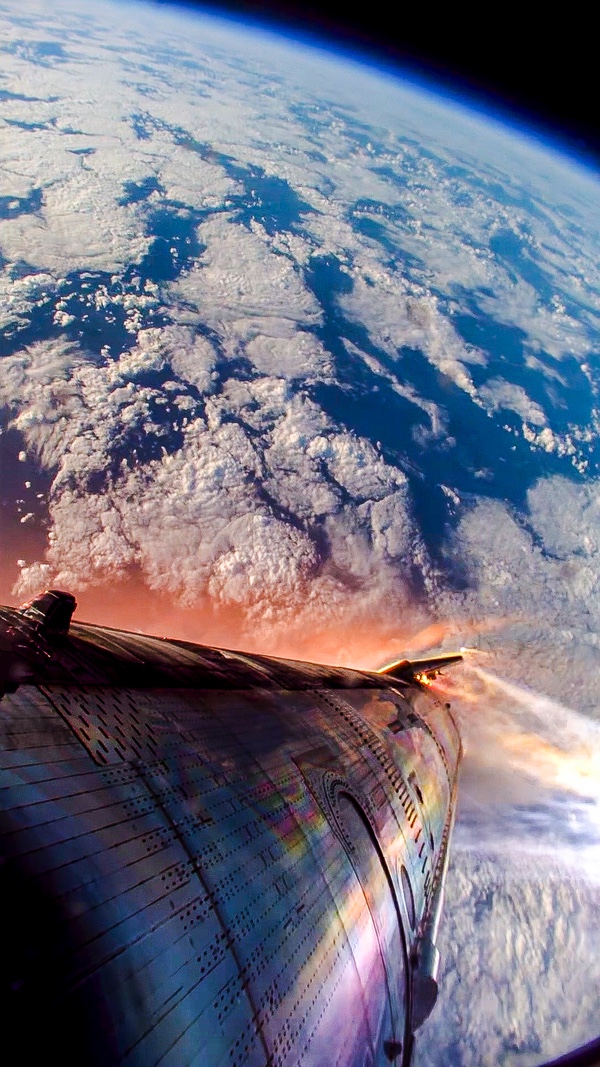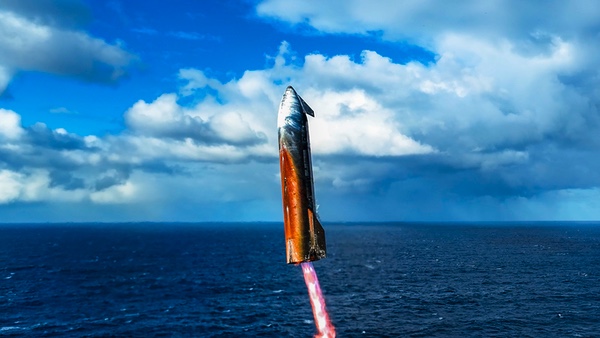Back in the win columnby Jeff Foust
|
| The failures prompted speculation of design flaws imperiling the program. |
One program, though, has been weighing down the company: Starship. The company’s first three test flights of the vehicle this year—in January, March, and May—all suffered mission-ending failures. The first two encountered problems during Starship’s ascent that caused the vehicle to reenter and break apart over the Caribbean, while the third completed its ascent but lost attitude control while in space, leading to an uncontrolled reentry over the Indian Ocean (see “Starship setbacks and strategies”, The Space Review, June 9, 2025.)
Then, in June, another Starship upper stage was destroyed during preparations for a static-fire test, an issue that the company traced to a faulty composite-overwrapped pressure vessel (COPV) that burst below its rated pressure. One industry observer, speaking on background, noted that the company appeared to be regressing: after demonstrating last year it could fly Starship to pinpoint splashdowns in the Indian Ocean while “catching” the Super Heavy booster back at the launch site, the company was now making mistakes not seen since much earlier in Starship’s development.
The failures prompted speculation of design flaws imperiling the program. “Can SpaceX Solve Its ‘Exploding Starships’ Problem?” asked the headline of a Scientific American article last month, speculating that all three failures were linked a problem with harmonic oscillations with the Starship upper stage that SpaceX said it corrected after the January failure. Another inquisitive headline came from New York magazine: “Is Elon Musk’s Starship Doomed?” It was not so much about vibrations than just bad vibes, as it rounded up comments from a group that ranged from a blogger to a space architect expressing skepticism that Starship could work.
 Starship/Super Heavy takes off on its tenth test flight. (credit: SpaceX) |
A (nearly) perfect ten
That was the environment facing the Starship program as it prepared for its tenth Starship/Super Heavy launch. The plan for Flight 10 was similar to recent test flights, in large part because SpaceX wasn’t able to carry out many of the tests planned for those previous flights. That included the deployment of mass simulators of next-generation Starlink satellites through Starship’s slot-shaped payload door. (Since Starship was flying a suborbital trajectory, the payloads would burn up on reentry minutes later.) Also on tap was a relight of a Raptor engine while in space, something completed on just one previous test flight but essential to plans for future orbital flights.
If all went according to plan, Starship would splash down in a designated region of the Indian Ocean a little more than an hour after liftoff. The Super Heavy booster, as with the previous flight, would not be recovered back at the launch site but instead attempt a soft splashdown just off the coast after performing tests.
After a first launch attempt was scrubbed August 24 because of a group equipment issue and second the next day due to weather, the vehicle finally lifted off at 7:30 pm EDT August 26 from the Starbase, Texas, test site on the Gulf coast. And what was remarkable about the next 66 and a half minutes was that the flight followed the plan, almost to the letter.
Starship completed its ascent without incident, while the Super Heavy booster flew back to a designated area off the coast, testing alternative engine configurations for a final landing burn, hovering just off the water before splashing down .Starship, now on its suborbital arc, opened its payload pay door and released eight Starlink mass simulators using the “Pez” dispenser, so named after the candy. Later, one Raptor engine ignited for a few seconds.
Then came reentry. Cameras on the exterior of Starship, connected via Starlink, provided high-resolution video of the vehicle enduring the heat of its passage through the upper atmosphere. SpaceX had said that, if Starship survived and the reentry was on target, a camera on a buoy in the Indian Ocean would be able to capture images of the final phases of flight, with the vehicle pitching up for a landing burn.
| “It’s not been an easy year but we finally got the reentry data that’s so critical to Starship. It feels good to be back!” Diez said. |
The reentry was on target, and that camera captured the vehicle making that final maneuver before settling down onto the surface of the water, falling over, and breaking apart. That video, though, show Starship was oddly discolored, with the nose appearing white and much of the body a rusty orange-red. SpaceX CEO Elon Musk later said it was linked to experiments with the vehicle’s thermal protection system: white from insulation in areas where tiled had been intentionally removed before launch, and the rust color from metallic test tiles. “Worth noting that the heat shield tiles almost entirely stayed attached, so the latest upgrades are looking good!”
The flight was not perfect. One of 33 Raptor engines in the Super Heavy booster shut down during ascent. Early in reentry, something appeared to break apart in the aft skirt of Starship, while one flap showed some damage; neither appeared to affect reentry and landing burn.
The company, though, declared success. “Every major objective was met, providing critical data to inform designs of the next generation Starship and Super Heavy,” SpaceX stated in a summary of the flight.
 Starship during reentry on the August 26 flight. (credit: SpaceX) |
Playing from behind
The flight had ended a streak of three test flights where many, if not most, major objectives were not met, as well as the ship destroyed in ground testing. It was clearly a relief to the company and its employees. “The last 4 vehicle failures and countless hours by engineering teams and technicians working to correct for the lessons we learned got us to a great outcome today,” Shana Diez, director of Starship flight reliability at SpaceX, said in a social media post hours after the flight.
“It’s not been an easy year but we finally got the reentry data that’s so critical to Starship. It feels good to be back!” she added.
Starship might be back, but it’s also behind. That string of failures means the program is lagging schedules it set for itself, and with NASA, for development of the vehicle to meet the company’s needs—launching next-generation Starlink spacecraft—as well as for NASA’s Artemis program.
It’s the latter that has attracted more attention given the increasing rhetoric, at least in the US, about a new space race with China to see who can land the first astronauts on the Moon since the Apollo program. China is making steady progress on launch vehicles and spacecraft needed for a landing that the country has projected to take place by 2030.
That would still be a few years behind the official NASA schedule, which continues to project Artemis 3 taking place in 2027. Sean Duffy, the secretary of transportation who was named acting NASA administrator nearly two months ago, has repeatedly stuck to that schedule in public comments, including a string of television interviews.
“In 2027, we WILL return American astronauts to the Moon,” he posted on social media August 28 (emphasis in original), including a clip from a CBS News interview where he reiterated that he believed the schedule was realistic: “I think we’re on track, where we sit today, to keep the 2027 mission in play.”
However, SpaceX is behind scheduled previously announced by NASA for key milestones in Starships’ development needed for the Artemis lunar lander version of the vehicle. At a briefing in April 2024, just after the third Starship/Super Heavy flight that included a transfer of cryogenic propellants from one tank to another within Starship, NASA officials said they expected to perform the first ship-to-ship transfer of propellants in 2025. That will require placing one Starship into orbit and then launching another to dock with it, demonstrating the refueling needed for sending a lunar lander Starship to the Moon.
The delays from the string of failures make it highly unlikely that SpaceX will be able to demonstrate that in-space propellant transfer this year.
| “They feel very comfortable on Starship. They feel like they’re on pace for the lander,” Duffy said of SpaceX. “They said if there’s a holdup for Artemis 3, it’s not going to be them.” |
“The key milestone that we are watching for, and everyone is watching for, is when will they be able to demonstrate cryogenic propulsion transfer,” Lori Glaze, NASA associate administrator for exploration systems development, said at a July 25 meeting of the Space Studies Board. “We were anticipating that would be completed by this year. Clearly, that is slipping, but we are anxiously watching for their next launch to see how they’re making progress towards achieving that particular milestone.”
She didn’t indicate when NASA now expected that propellant transfer test to take place, but it is essential to later milestones, including an uncrewed test flight of the Starship lander, touching down on the Moon and then taking off again. Completing that mission will require multiple Starship “tanker” launches to fill the lander’s propellant tanks with liquid oxygen and methane: perhaps 15 to 20, some argue, although neither NASA nor SpaceX have provided an updated estimate.
Getting all that done in order to support a 2027 Artemis 3 mission would appear to be a tall order. At the Space Studies Board meeting, Glaze showed a chart of milestones leading up Artemis 3, including Starship testing. The chart, though, did not include dates. Asked for a schedule by board members, she said NASA had a more detailed schedule she could provide to the committee; if she did, that document was not disclosed.
Duffy, attending a Crew-11 launch attempt at the Kennedy Space Center a few days later, said he had met with SpaceX executives about the Artemis 3 schedule and received assurances. “They feel very comfortable on Starship. They feel like they’re on pace for the lander,” he told a group of social media influencers who were guests of the launch. (Duffy did not attend any of the pre- or post-launch media briefings organized by NASA.) “They said if there’s a holdup for Artemis 3, it’s not going to be them.”
The question is now less about whether SpaceX can keep Starship from exploding—it did, at least for this flight—than if it can keep its development schedule from exploding, with consequences that go beyond just a launch vehicle program.
Note: we are now moderating comments. There will be a delay in posting comments and no guarantee that all submitted comments will be posted.
